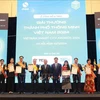With an annual production of about 25 million tonnes, accounting for 55 percent of the country’s total rice production, the Mekong Delta has become the largest rice granary in the country, said the Communist Party of Vietnam (CPV) Online Newspaper.
However, post-harvest losses are still high and this has resulted in poor improvement of farmers' living standards. It is necessary to apply modern technology to improve the quality of rice and minimize post-harvest losses, said the newspaper.
According to Dr. Pham Van Tan, from the Vietnam Institute of Agricultural Engineering & Post-Harvest Technology (SIAEP), the rice supply chain consists of a logical technological process in the following stages: breeding, cultivation (planting and care), harvesting, drying, storage, husking, processing and consumption.
In the chain of the process, the quality of product does not only depend on the quality of the technology applied during that stage, but also depends on the quality of the technology at every previous stage.
Development of the rice supply chain in the Mekong Delta, has shown that the purpose of the preservation is to ensure the quality of rice. Most farmers in the Mekong Delta can only afford to preserve rice seed for next crop and harvested rice for family consumption.
If they cannot sell rice immediately after preliminary drying, due to too low market prices farmers often temporarily store rice in PP bags or jute bags of 30 - 50kg. They pile them anywhere available and cover them with canvas to protect them from the rain and frogs between one and two weeks at best and several months at worst. This method of storage, for any period, reduces the quality of rice and cause economic losses.
In recent years, drying rice by machine after harvest has developed significantly in the Delta, accounting for about 47 percent of the crop compared to the demand.
To reduce the post harvest losses, the drying and preservation of rice are two key steps that need to be standardized throughout the Mekong delta in an effort to improve farmers’ living standards in the region.-VNA
However, post-harvest losses are still high and this has resulted in poor improvement of farmers' living standards. It is necessary to apply modern technology to improve the quality of rice and minimize post-harvest losses, said the newspaper.
According to Dr. Pham Van Tan, from the Vietnam Institute of Agricultural Engineering & Post-Harvest Technology (SIAEP), the rice supply chain consists of a logical technological process in the following stages: breeding, cultivation (planting and care), harvesting, drying, storage, husking, processing and consumption.
In the chain of the process, the quality of product does not only depend on the quality of the technology applied during that stage, but also depends on the quality of the technology at every previous stage.
Development of the rice supply chain in the Mekong Delta, has shown that the purpose of the preservation is to ensure the quality of rice. Most farmers in the Mekong Delta can only afford to preserve rice seed for next crop and harvested rice for family consumption.
If they cannot sell rice immediately after preliminary drying, due to too low market prices farmers often temporarily store rice in PP bags or jute bags of 30 - 50kg. They pile them anywhere available and cover them with canvas to protect them from the rain and frogs between one and two weeks at best and several months at worst. This method of storage, for any period, reduces the quality of rice and cause economic losses.
In recent years, drying rice by machine after harvest has developed significantly in the Delta, accounting for about 47 percent of the crop compared to the demand.
To reduce the post harvest losses, the drying and preservation of rice are two key steps that need to be standardized throughout the Mekong delta in an effort to improve farmers’ living standards in the region.-VNA



















